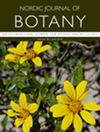Floristic composition, natural history traits and habitat affiliation in vegetation of major forest types in Jammu and Kashmir, western Himalaya
IF 1.1
4区 生物学
Q3 PLANT SCIENCES
引用次数: 0
Abstract
Documenting floristic diversity, its natural history traits and habitat affiliation offers crucial insights for developing conservation strategies and management plans for regional biodiversity. In this study, we employed random sampling technique to investigate the floristic composition, natural history trait diversity and habitat distribution among 12 major forest types spread across an elevational gradient of 350–3450 m a.s.l. in the western Himalayan region of Jammu and Kashmir. We recorded 451 species belonging to 90 families in the study region, with herbaceous growth form, perennial life span and therophyte categories dominant. We observed a steady increase in species richness from 800 to 2000 m a.s.l., with highest at 1750 m a.s.l. in the Himalayan dry temperate forest type and then a decreasing trend with elevation. In terms of species turnover, the lowest dissimilarity of 36.8% was found between the Himalayan dry temperate and Fir forests. Whereas, considering species replacement (β喜马拉雅西部查谟和克什米尔主要森林类型植被的植物组成、自然历史特征和生境归属
记录花卉多样性、其自然史特征和栖息地归属为制定区域生物多样性保护战略和管理计划提供了重要的启示。在这项研究中,我们采用随机抽样技术,调查了查谟和克什米尔西部喜马拉雅地区海拔 350-3450 米梯度范围内 12 种主要森林类型的植物组成、自然历史特征多样性和栖息地分布情况。在研究地区,我们记录了隶属于 90 个科的 451 个物种,其中以草本植物、多年生植物和食草植物为主。我们观察到,从海拔 800 米到 2000 米,物种丰富度稳步上升,其中海拔 1750 米的喜马拉雅干温带森林类型物种丰富度最高,然后随着海拔的升高呈下降趋势。在物种更替方面,喜马拉雅干温带森林与冷杉林之间的差异最小,仅为 36.8%。而在物种更替(βsne)方面,喜马拉雅山西部下段森林与喜马拉雅山干温带森林之间的相似度最高,为 17.3%。这表明,不同森林类型之间的贝塔多样性模式主要是由物种替换驱动的。多元分析揭示了整个森林物种库中的三大类。从栖息地来看,34%的物种被记录在自然栖息地,而其余66%的物种被发现于人类改造的栖息地(路边、树围)。我们的研究结果将提高人们对喜马拉雅地区森林植被的科学认识,并有助于指导森林政策和管理。
本文章由计算机程序翻译,如有差异,请以英文原文为准。
求助全文
约1分钟内获得全文
求助全文
来源期刊

Nordic Journal of Botany
生物-植物科学
CiteScore
1.90
自引率
11.10%
发文量
100
审稿时长
2 months
期刊介绍:
Nordic Journal of Botany publishes original contributions on all aspects of the taxonomy, evolution, conservation, ecology and biogeography of plants (including algae and bryophytes) and fungi.
 求助内容:
求助内容: 应助结果提醒方式:
应助结果提醒方式:


